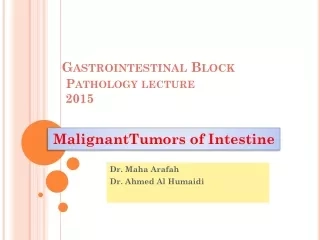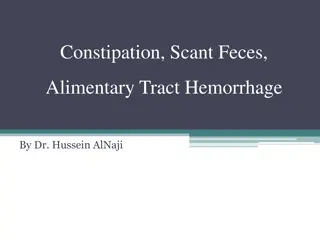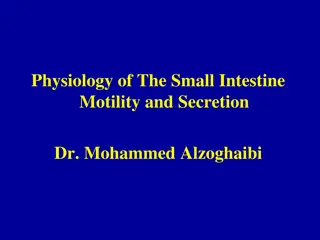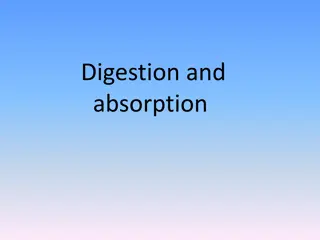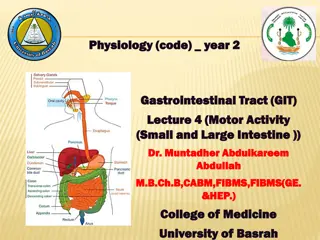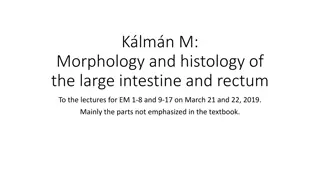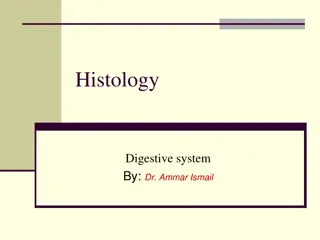Anatomy of Intestine in Domestic Animals
The intestine in domestic animals plays a vital role in digestion and absorption. It consists of the small intestine for chemical digestion and absorption and the large intestine for water absorption and excretion. This article covers the gross anatomy, histology, and embryology of the intestine, detailing the structure and function of different parts like the duodenum, jejunum, ileum, cecum, colon, and rectum. It discusses the intestinal juice, mucosa protection, anatomy of ruminants' intestines, and key measurements like length and diameter of the small intestine.
Download Presentation

Please find below an Image/Link to download the presentation.
The content on the website is provided AS IS for your information and personal use only. It may not be sold, licensed, or shared on other websites without obtaining consent from the author.If you encounter any issues during the download, it is possible that the publisher has removed the file from their server.
You are allowed to download the files provided on this website for personal or commercial use, subject to the condition that they are used lawfully. All files are the property of their respective owners.
The content on the website is provided AS IS for your information and personal use only. It may not be sold, licensed, or shared on other websites without obtaining consent from the author.
E N D
Presentation Transcript
Gross, histological and developmental Anatomy of intestine in domestic animals
TOPICS TO BE DISCUSSED 1. Gross Anatomy 2. Histology 3. Embryology
Gastrointestinal tract Rima oris to anus 1.Oral cavity- tongue,teeth,salivary glands,hard palat and soft palat 2.Pharynx 3. Esophagus 4.Stomach 5.Intestine 6.Liver 7.Pancrease 8.Spleen
Introduction The intestine plays an important role in the digestion and absorption of various nutrients. Small intestine : chemical digestion and absorption. Large intestine: absorption of water and excretion. Intestinal juice- Succus entericus - is derived from the intestinal glands/ crypts of lieberkuhn and duodenal glands. Intestinal juice contains hormones, digestive enzymes, mucus substances to neutralize hydrochloric acid coming from the stomach. The mucus secreted by the goblet cells lubricates and protects the mucosa. (Frandson, 1986, Getty 2012)
Intestine : The part of alimentary canal which extend from pylorus of stomach to anus . It consist of two parts: Proximal part- small lumen Small intestine Distal part -wider lumen- Large intestine Small intestine: Part of the gastrointestinal tract between the stomach and large intestine. 3- distinct regions duodenum, jejunum, and ileum. The first part duodenum is attached by a short fold, the Mesoduodenum, while remainder is attached by Mesentery and is divided into jejunum and ileum. The line of demarcation is arbitrarily set at the free edge of the ileocecal fold. The duodenum is initimately related postionally with liver to which it is connected by Hepatoduodenal ligament. Duodenum also receives bile duct and pancreatic duct.
large intestine: Extend from the termination of ileum to anus. It is divided into cecum, colon, and rectum. Cecum is a blind sac with an opening into beginning of the colon. Colon begins at cecocolic orifice to rectum at pelvic inlet. There is no line of demarcation between colon and rectum; the plane of pelvic inlet may be demarcation line. Rectum is extends from pelvic inlet to anus. Anus- terminal part , below root of tail
Gross Anatomy: Ruminants Topography: lies entirely to right side of median plane chiefly in contact with right face of rumen and attached to sub lumber region by common mesentery. Small intestine: Convoluted tube extend from pylorus to ileo-cecal orifice. Biometry: Average length: 39-42 meters Duodinum- about 1.2 meters Jejunum- about 38-40 meters (longest segment) Ileum- about: 0.8 meters Average Diameter: 5-6 cm The jejunum was the longest and widest segment of small intestine.
Duodinum Three parts: 1.Cranial part- form Ansa sigmoidea S-shaped curve on visceral surface of liver. 2. Descending part: goes up to almost tubercoxae and form caudal/illiac flexor. Passing right to left around root of mesentery. . 3. Ascending part: extend forward and terminate at duodenojejunal flexor which lies on left side of cranial mesenteric artery.
-Bile duct opens in 2nd curve of ansa sigmoidea, 50-60 cm from pyloric end. -Pancreatic duct opens 80- 90 cm from pylorus or 30 cm further back from bile duct. -In sheep/ goat bile and pancreatic duct join together and open into duodenum about 25-40/20 cm from pylorus.
Jejunum Arranged in numerous very close coils, U shaped tubular loops/ festoons by attachment of mesentery. Lies chiefly in space bounded medially by right face of ventral sac of rumen and right abdominal wall, dorsally by large intestine and anteriorly by omasum and abomasum
Ileum Terminal part of jejunum leave the edges of mesentery and runs forward between cecum and colon. Line of demarcation between cecum and colon is opening of ileum into cecum.
Large Intestine : 10-11 meters Avg diameter- 15 cm Lies between layers of common mesentery in the dorsal part of the right half of the abdominal cavity. Caecum: (0.8m in length and 12 cm in diameter) cylindrical blind sac goes up to pelvic inlet 2 orifices- ileocaecal small, caecocolic- large Caecum is directely continuous infront with colon.it usually near ventral end of last rib.
Colon 10 meter in length, 12 cm in diameter which diminishes in course of proximal loop up to 5 cm largest part of Large Intestine From caecocolic orifice to rectum lies between layers of mesentery ,coiled upon itself in such a manner as to form number of elliptical convulsions. 3 parts Ascending (loop part)- longest part Transverse part Descending part
C A. Ascending colon : a.Proximal loop: runs Cranially- Caudally -Cranially -Ventrally b.Spiral loop: 2 centripital coils, a central flexur and 2 centrifugal coils ( in sheep/ goat :3-3) Form a disc shape situated in right lateral upper abdomen c. Distal loop: terminal portion of centrifugal part of spiral loop, continuous with transverse colon. B.Transverse colon: Passes from right to left around the cranial mesenteric artery. C. Descending colon : Become continuous with rectum. Artery A c B a b
Rectum 30 cm 2 parts: Cranial Covered by peritoneum and variable in position Caudal - Retroperitoneal and form ampulla recti Wall presents constriction and dilation. Anus (Anal canal) Terminal part of GIT situated below root of tail (below about 4th coccygeal vertebrae) Have 02 sphincter- 1. sphincter ani internus-smooth muscle 2. sphincter ani externus-skeleton muscle
Intestine of Horse Small intestine 22-24 meter long, (7.5-10 cm) Duodenum- about 1m Jejunum- about 20 m Ileum - about 1 m Location -Lies in Dorsal part of left half of abdomen, coils reach to floor and pelvic cavity. Duodenum Horse shoe shape 3 parts- 1. Cranial- curve 2.Descending- fixed with right dorsal colon 3.Ascending- fixed with base of caecum -concavity of 2nd curve have hepeto-pancreatic ampulla/ diverticulum duodeni/opening of bile and pancreatic duct (cm from pylorus) shape S
Jejunum and ileum- No distinction between two(Last meter is the ileum) -Numerous coils intermingled with small colon Large intestine Characterised by bands and sacculations Caecum It is very big comma shaped cul-de-sac situated from right iliac and sub- lumber region to abdominal floor caudal to xyphoid cartilage 03 parts- base,body and apex - Have both ileocaecal and cecocolic orifice in lesser curvature of base situated 5-7.5 cm apart. In between the two Intervening fold is present - Both opening also have sphincter ilei and sphincter caeci
04 longitudinal bands (Teniae ceci) and 04 rows of sacculation (Haustra ceci)
Caecum Right side
Colon of horse 02 parts 1. Great colon (Ascending part) 2. Small colon (descending part) Great colon Begins from cecocolic orifice (at base of caecum)and terminate by joining small colon behind the saccus caecus of stomach. Have 04 parts and 03 flexures 1. Right ventral 2. Left ventral 3. Left dorsal 4. Right dorsal
1. From the base of caecum (at last rib) up to xyphoid cartilage, than it bends sharply to right side form sternal flexure 2. Left ventral- passes caudally up pelvic inlet and bends dorsally to form- pelvic flexure 3.Left dorsal- passes dorsally or lateral to left ventral and reach up to diaphragm and bends Diaphragmatic flexure 4.Right dorsal- passes dorsal to right ventral colon and reach to base of caecum. it turn to left and dorsally behind left sac of stomach, here it becomes constricted, joins small colon below the left kidney. Right ventral to form and
Small colon- from termination of large colon to rectum. Lies in space between stomach and pelvic inlet, dorsal to left part of great colon Mingled with small intestine but easily distinguished by 02 rows of bands and sacculations Attach to sub lumbar muscle by mesocolon and to termination of duodenum by duodinocolic fold of peritoneum Arranged in coils
Caliber of colon: Great colon- at its origin about 5-7.5 cm- Soon increase to 20-25 cm for ventral parts- beyond pelvic flexure diameter reduced to about 8-9 cm.- towards the diaphragmatic flexure the caliber rapidly increases, and reaches its maximum in last part (Right dorsal)- 50 cm. This succeeded by a funnel shaped terminal contraction. Small colon- diameter about 7.5-10 cm Rectum: as ox Applied: at pelvic flexure chances of obstruction of dry faecal material /indigestion causes colic
intestine- Dog Duodenum- Retrograde/1st part from pylorus passes caudally and somewhat dorsally to visceral surface of liver,near pelvis turn medially (illiac flexure)and passes cranially. Recurrent/2nd part From illiac flexure passes cranially and bends ventrally to join jejunum. Bile duct and smaller pancreatic ducts open- 5-8 cm from pylorus Larger pancreatic duct opens 2.5-5 cm further from bile duct or 7.5-13 cm from pylorus
Jejunum- 6-8 coils between liver and stomach Ileum- Ileum opens into colon at ileal opening and there is ileal papilla/ileocolic valve -Ileum communicate only with colon. -ileocolic and caecocolic orifices close and caecum present as a diverticulum of colon Caecum- cork screw shape bands and sacculation absent Caecum
Rectum Caecum Stomach
Colon of dog bands and sacculation absent 03 parts 1. Ascending- cranially go up to pylorus 2. Transverse short 3.Descending- up to ventral surface of left kidney Rectum of dog anal glands present 02 lateral anal sacs present which contains dirty gray, fatty substance and unpleasant odour Skin which lines these pouches contains coils glands Further caudally skin contains large sebacious Circumanal glands Rectum almost completely covered by peritoneum
Pig Small intestine: Duodenum: cranial,descending and ascending Opening of bile duct 2.5 cm from pylorus and pancreatic duct- 10 cm Caecum- cylindrical shape 03 longitudinal muscular bands (teniae) 03 rows of sacculations (haustra) Opening of ileum and colon apart. Franulum ilei- a fold of mucous membrane passes each side of ileo-caecal opening
Colon lies chiefly to left of median plane caudal to stomach 03 parts 1. Ascending colon- arrange in 3 close, double spiral coils in relation with floor of abdomen, ventrally runs cranially up to stomach and turns left as 2. Transverse colon- which passes caudally as 3. Descending colon- reach to pelvic inlet 02 teniae and haustra present in ascending colon
Ox Dog Pig Horse
Species differentiation: Small intestine Ox Horse Dog Pig Size 40 to 42 meter long, (5 cm diameter) 22-24 meter long, (7.5-10 cm) 1.8-4.8 m, (2.5 cm) 16-21 meter,( 4 cm) Duodenum- 1 m Jejunum- 40 m Ileum -1 m Duodenum- 1m Jejunum- 20m Ileum -1 m Duodenum-0.2- 0.6 m Jejunum &Ileum- 1.6-4.2 m Duodenum-0.7- 0.95 m Jejunum &Ileum- 15- 20m Position Right half of abdomen with few coils caudal and ventral to rumen. ventral to large intestine. Duodenum is often highest part of tube in right flank. Dorsal part of left half of abdomen, coils reach to floor and pelvic cavity. Duodenum mainly in right costal region When stomach empty , lies ventrally and caudally (right flank)but forced more caudally when stomach full. Duodenum as cow. Mesenteric part above the colon and to right of cecum. Against dorsal right flank and caudal abdominal floor. Duodenum as cow.
Small intestine Ox Horse Dog Pig Bile duct and pancrea tic duct Separate Common , diverticulum duodeni/ Ampulla of vater/ hepatopancreat ic ampulla Separate Separate Ileocolic valve is present. Absent Absent Present Absent
Large intestine Ox Horse Dog Pig Size 10-11 meter long 7.5 -8.0 meter long 60-75 cm 4-4.5 meter Cecum Length Diameter 0.8 m 12cm 1.25 m 20-25cm 12.5 15 cm 2.5-4 cm 20-30 cm 7.5-10cm Shape Cylindrical with rounded free extremity Comma shaped with 4 longitudinal bands. One extremity rounded(base)and pointed(apex) Cork Screw and coiled Cylindrical and sacculated with 3 longitudinal bands. Extremity rounded Position Extend along flank from near ventral end of last rib to the pelvic inlet Base extend from 15th rib to tuber coxae on right of median Longitudinal extends over right flank to xiphoid region. On right midway between flank and median plane, dorsal to umblical region Vertical position in left or right flank, reaching abdominal floor between umblicus and pubis plane. axis ventrally
Large intestine- cecum: Ox Horse Dog Pig Opening s Colon and cecum continuous. Ileum joins obliquely. Ileum and large colon enter at lesser curvature of base. Opening are 5 cm apart Ileum and colon continuous and cecum joins obliquely. As cow
Large intestine- colon : Ox Horse Dog Pig Length- Diameter- 10 m 7.5cm Large colon 3-3.7 m , 3-3.5 Small colon 20- 25cm,7.7-10 cm 40-50 cm 2.5 cm 3.5-4 m 5 cm In dorsal abdominal cavity, to right of median plane with small intestines. Coiled part in lower right flank Large colon: mainly in ventral abdominal cavity as dorsal and ventral coils. Extends from sternum to pelvic brim. Small colon: Dorsal to large colon and mingled with small intestine. Short ascending part lies along right flank, with long descending part on left of median plane extending to pelvic cavity On each side of median plane, mainly to left caudal to the stomach. Coiled part in ventral part of abdominal cavity, dorsal to umblicus Position
Large intestine- colon and rectum : Ox Horse Dog Pig Specific character Tubular, no bands and sacculation. Part is coiled . 3parts Ascending,transv -erse and descending. Rectum:Ampulla recti present Sacculated with longitudinal bands, 1-4 on large colon 1-2 on small colon. Great colon- 4 parts/ 3 flexures No bands,Short and like shepherd s crook. 3parts : Ascending, transverse and descending Coiled like ox but colon have 2 bands and 2 sacculations Rectum: Ampulla recti present
Ox Dog Pig Horse
Attachments :ox Duodenum: Cranial part of duodenum- lesser omentum Descending part and caudal flexure attach dorsally to mesoduodenum and descending part attached ventrally to superficial wall of omental bursa. Ascending part attached to descending colon by duodenocolic ligament and to proximal and distal loop of ascending colon by adhesions around root of mesentery. Jejunum: Usually lies in supraomental recess (mesenteries) Ileum : Cranial part is adherent to cecum. Cecum : Cranial 2/3rd adherent to right side of mesentery. Dorsally to proximal loop of colon by cecocolic fold, ventrally to ileum by ileocecal fold. Colon : Spiral loop lies in between layers of mesentery. The proximal and distal loop and cranial part of descending colon adherent to cranial part of cecum and ascending duodenum in a fat filled mass around root of mesentery. Rectum: A short mesorectum near sacral promontary.
Attachments :Horse Duodenum/ fixed part : by mesoduodenum, cranial part to liver and descending part to right dorsal colon, base of cecum, right kidney and sublumbar muscles. Jejunum and ileum /mesenteric part: by mesentery to dorsal abdominal wall. Ileocecal fold attaches ileum to lesser curvature of cecum. . Cecum : Base attach dorsally by connective tissue and peritoneum on ventral surface of pancrease and right kidney. Body attached dorsolaterally to first part of colon by cecocolic fold. Apex is free. Colon : Right ventral part of great colon attached to lesser curvature of cecum by 2 layers of peritoneum, which form cecocolic fold. Right parts and left parts are united by peritoneum on either side. The transverse colon attached by peritoneum to pancrease dorsally and base of cecum laterally. Small colon attach to sublumber region by mesocolon and to termination of duodenum by narrow duodenocolic fold. Rectum: Mesorectum , continuation of mesocolon.
Vessels and Nerve Small intestine: (beginning of duodenum is supplied by branches of Celiac artery. Other portion is supplied by Cranial mesenteric artery). Cranial part of duodenum- right gastric and right gastroepiploic artery Descending part- cranial and caudal pancreatoduodenal artery Ascending part- branch of cranial mesenteric artery from left side and from middle colic artery Jejunum jejunal arteries (branches of cranial mesenteric artery). In ox a collateral branch originates from concave surface of cranial mesenteric artery and passes obliquely across the mesentery to rejoin the cranial mesenteric artery. Collateral branch absent in sheep and goat. Ileum 2 arteries: ramus ilei mesenterialis come from ileocolic artery and ramus ilei antimesenterialis is termination of cecal artery. Both of which anastomose with terminal branches of cranial mesenteric artery. Veins of small intestine are generally satellites of arteries but gastroduodinal and caudal mesenteric vein are branches of portal vein which extends from liver to terminal branches, the cranial and caudal mesenteric veins.
Large intestine: (cranial and caudal mesenteric arteries) Small middle colic artery arise from cranial surface of cranial mesenteric artery and supply transverse and descending colon. The ileocolic/ileocecocolic artery is a large trunk that gives colic branch which supply proximal, distal and coiled loop Cecal artery runs in ileocecal fold, supplies the cecum and ileum. Branches of ileocolic vein are satellites of branches of ileocolic artery. The caudal mesenteric vein gives off middle colic and left colic veins. Rectum: cranial rectal artery from caudal mesenteric artery and by several short middle rectal branches from urogenital artery. The anal canal supplied by terminal branches of cranial and middle rectal artery. Nerve supply The intestine gets sympathetic fibres from celiac, cranial mesenteric and caudal mesenteric ganglions and parasympathetic fibres from vagus and pelvic splanchnic nerves. Rectum also innervated by caudal rectal nerve.



